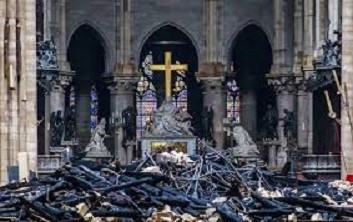

![]()
under the patronage of St Joseph and St Dominic
By the rivers of Babylon there
we sat and wept, remembering Zion;
on the poplars that grew there we hung up our harps. . . Ps 136

 |
under the patronage of St Joseph and St Dominic By the rivers of Babylon there
we sat and wept, remembering Zion; |

|
|
|
WHAT'S WRONG WITH THE NOVUS ORDO—PART III
The Ceremonies of Holy Week
“Sicut ovis ad occisionem ductus est, et dum male tractaretur, non aperuit os suum: traditus est ad mortem, ut vivificaret populum suum..
Response 1, Matins (1st Nocturn) Tenebrae, Holy Saturday[1]
Download this document as a
When, after decades of attendance at the novus ordo, the writer began a return to the Latin rite which he had served as a boy, something occurred at Mass at St Brigid’s, Canberra, which highlighted the difference between the two and exposed one of the new rite’s fundamental flaws.
After the consecration the priest intoned Praeceptis salutaribus moniti, et divina institutione formati, audemus dicere, and began the Pater Noster. Following the rubric of the novus ordo the writer joined in aloud only to desist as he realized that no other member of the congregation was doing so. The issue to which, in due course, this solecism woke him was the ineffable reality and dignity of the priesthood, for it is the priest in persona Christi who celebrates the Mass. The part played by the faithful is limited. In Mediator Dei Pope Pius XII quotes Innocent III to the point: “[W]hat is performed in a special way by the ministry of priests is done in a general way by the desire of the faithful”. When the priest recites the Pater Noster it is Christ, He Who has just sacrificed Himself anew via the double consecration, Who prays it on behalf of the faithful. Christ calls upon His Father with the evidence of the sacrifice of Calvary before Him anew to have mercy on the faithful and all the world. This is evidenced further by the fact that only once in the Year does the Church in her liturgy in forma extraordinaria require the faithful to join the priest in the Pater Noster, on Good Friday before they receive the Eucharist reserved from Mass on Holy Thursday.
The dysfunctional rubric of the novus ordo which mandates lay intervention here reflects the falsity encapsulated in Vatican II’s Protestant inspired assertion of ‘the priesthood of the laity’.
At Low Mass in the Tridentine rite one may follow ipsis verbis the priest in his actions. The Latin is not hard and a translation in the vernacular reduces the difficulties. The rubrics assist with their punctuation of the text. You can accompany the priest as he makes his way. In a Missa Cantata or Solemn High Mass, however, one is relegated with the schola to singing the Introit, Gradual and other parts of the Proper, and the Kyrie, Gloria and other parts of the Common. Being prevented from following each step of the Mass (so to speak) matters not for it is the priest who is performing the sacred action, and one can leave to him one’s intentions for the living and the dead.
* *
Nothing demonstrates so vividly the shortcomings of the novus ordo as the banality of its celebration of Holy Week, the most critical passage in the Church’s liturgical year. The pomp that marks the original rite in Latin and the manner in which it fills the days of the Easter Triduum contrast dramatically with the diminution of ceremony, the shifting texts and the optional shortenings that characterise the novus ordo.
Palm Sunday Ceremonies In the forma extraordinaria the long Gospel passage is fixed; it is that of St Matthew. The threefold division of the voices (reflected, in bland recitation, in the novus ordo) of Christ, of the Narrator, and of all the other players in the passage related (the Other voices) is observed in the drama of what is sung. The Narrator observes a middle tone suitable to narrative; Christ speaks, or responds, in a lower tone, the pitch of reason and counsel. The Other voices take a higher tone, the pitch at which anger, regret and sorrow are expressed. By exciting the emotions in this way the Church enhances the effects of the narrative upon the faithful who attend. There is one other difference to the protocol introduced with the novus ordo. The three are faced, not towards the faithful—as if performing for an audience—but at ninety degrees to the altar (and nave).
Tenebrae On the mornings of Holy Thursday, Good Friday and Holy Saturday, priests, deacons and choir sing the Offices of Matins and Lauds, the Tenebrae, with great solemnity.[2] The psalms of Matins are interspersed with nine Lessons, three after every three of the psalms, the most celebrated of which (the first three each day) are taken from the Lamentations of Jeremiah. The cantor sings them from the centre of the apse facing towards the altar. The nine psalms of Matins and the five of Lauds proceed without Gloria Patri in the presence of an elevated candelabrum whose fifteen candles are extinguished one by one as the psalms are completed until one alone remains. All other lights including those on the altar are extinguished as the Benedictus (Canticle of Zachary) is sung at the close of Lauds. After the final antiphon all kneel and sing— Christus factus est pro nobis obediens usque ad mortem.[3]
The Pater Noster is then said silently after which the celebrant recites, in sombre voice, the final prayer— Respice, quaesumus Domine, super hanc familiam tuam, pro qua Dominus noster Jesus Christus non dubitavit minibus tradi nocentium et Crucis subire tormentum. (then silently, Qui tecum vivit et regnat in unitate…)[4] The ceremony closes dramatically with the Strepitus. Every participant joins in thumping the pew and stamping his feet to produce a sound symbolising the earthquake that accompanied the death of Our Blessed Lord.
After this all depart in silence.
Good Friday Ceremonies The Gospel sung is that of St John (retained in the novus ordo). As on Palm Sunday the voices are heard at their respective pitches. Again the three are faced across the nave as they sing. After this, for the one and only time in the liturgical Year, the celebrant priest intones The Great Intercessions which address every possible intention. This is the only day of the Year (if one takes Holy Saturday as blended with its midnight celebration) when Mass is not said—that is, when Christ does not intercede for the faithful and for all the world in the repetition of His sacrifice. It is the only day of the Year in which prayers of the faithful are offered.

After the frightful fire on Monday in Holy Week in Notre Dame de Paris what remains? The altar on which for 800 years the immemorial sacrifice was celebrated, until the advent of the novus ordo.
* *
The loss of the celebration of the Tenebrae connived at by the reformers under Paul VI has led many in the novus ordo to try and fill the lacunae. Typical of such attempts was a proto-liturgy at the Cathedral of St Patrick in the Sydney suburb of Parramatta[5] on the evening of Monday, April 15, 2019, presided over by the Bishop, Vincent Long. Despite its participants’ best intentions the result, anachronistic, dislocated and disordered, was no part of the Church’s liturgy. To be more specific—
The result was not liturgical in either forma ordinaria (even with its smorgasbord approach to the liturgy) or forma extraordinaria. It was, in truth, little more than an evening concert.
Yet in fairness the event paid tribute to, and perhaps expressed regret over, the abiding loss of profundity that characterises the novus ordo in its celebration of the holiest week of the Church’s Year.
One might usefully address its proponents and those who entertain doubts that the novus ordo could ever satisfy the demands of the Catholic soul with the call of the prophet Jeremiah in his Lamentations repeated each day in the Tenebrae—
Jerusalem, Jerusalem, convertere ad Dominum Deum tuum.
Michael Baker April 21, 2019—Easter Sunday
[1] Like a sheep he was led to the slaughter: and though shamefully dealt with he did not open his mouth; he was delivered to death that he might give life to his people. [2] In this they follow the direction of Pius XII that these offices are not to be anticipated by being sung on the evening of the previous day (Maxima Redemptionis, November 16, 1955). It is asserted that this directive has detracted from the setting that demands that Tenebrae (lit. ‘darkness’, or ‘night’) should be sung at night. The complaint lacks logic. Nothing prevents them being sung between 3.30 or 4.00 am and dawn, the proper time for Lauds. [3] On Friday there is added: Mortem autem crucis. On Saturday there is added further: propter quod et Deus exaltavit illum et dedit illi nomen quod est super omne nomen. [4] On Saturday the prayer runs: Concede quaesumus, Omnipotens Deus: ut qui Filii tui resurrectionem expectatione praevenimus; eiusdem resurrectione gloriam consequamur (and in silence, Per eumdem Dominum nostrum Jesus Christum…) [5] Referred to facetiously as ‘St Aldi’s Cathedral’ for its appalling architecture and adornment. [6] The gratuitous addition of Allegri’s Miserere at the end of the ceremony in the Sistine Chapel from the mid-Seventeenth Century was abolished in 1870. |